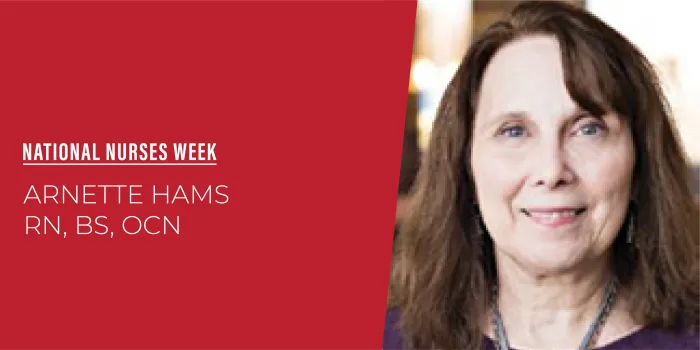Arnette Hams, RN, BS, OCN, began working with patients with bleeding disorders at Lehigh Valley Hospital in Allentown, Pennsylvania, in 1982. In her 37 years as a nurse, she’s seen significant changes in how hemophilia and other bleeding disorders are treated. From troubling times in the 1980s to much more hopeful days now, the constant has been Hams’ dedication to being the best advocate she can be for her patients. Despite closing in on four decades of work in the bleeding disorders community, Hams says, “it went by fast. I don’t feel that many years have gone by in my life, but obviously it has.”
EARLY INSPIRATION
I had an aunt that was a nurse, and I always really admired her, so I thought that would be a good career for me. I was not a real healthy kid. I was around doctors a lot, and I think that’s another reason why I thought it might be a good profession. I became a nurse in 1975, and back in the ’70s there weren’t a whole lot of choices for females, either.
THEN AND NOW
I joined the hemophilia program in 1982. I was a surgical nurse prior to this, but I knew the hemophilia nurse and she was leaving, so I applied. It sounded exciting—a new role to try to fulfill. I got the job, and I’ve been here ever since. I was the only full-time Registered Nurse until 2013.
When I started, Lehigh Valley did not have a pediatric hematologist, so our care was done for adults and children with adult hematologists. Now we have adult and pediatric doctors, and our pediatric population is starting to grow. We’re fortunate to do the life span—and you don’t have to change nurses, you only have to change doctors, when you turn 18.
When I began, in most cases we were treating the bleed when it happened. Factor dosing was a lot less, which was for several reasons. Originally, the factor that was available was human derived. And obviously at the time when I started, we knew about hepatitis. We didn’t know about HIV until I was about six months into my job. I started in June, and the first hemophilia patient that was reported and made the paper was in August. Initially we were more worried about hep C—which at that time was called non-A, non-B hepatitis. But then very rapidly we were concerned that the blood had HIV contamination. The ’80s weren’t great.
Over the years, with the new products coming out, we started treating prophylactically, or before you have a bleed. The levels of dosing got higher to get people to keep their levels above 1%. It allowed people to be more aggressive in their therapy and also allowed them to be more active. You saw better joint health, which was great. Kids went from not doing too much activity to kids trying to ski. They’re able to live a more normal life.
And now we can use Hemlibra, which has really changed how patients look at their care and what we can offer patients. It’s just changed the whole outlook on hemophilia. Many of our patients that have started it (and we haven’t put everyone on it), they definitely see a change in their activity level and their pain level, which is exciting.
THE ROLE OF THE HTC NURSE
Patients do tend to ask to speak to the nurse first. In our clinic, our physicians aren’t in the office all the time. We’re right next to them, but they’re not always here. So the nurse is probably the first point of care, and they help coordinate whatever the patient needs. It might be their medication, or if they have a social issue they might call and speak to the nurse and then it gets transferred to a social worker. If a patient needs to be hospitalized, in many cases you’re coordinating with other specialties or you’re coordinating that the hospital has enough factor for them. You work a lot with insurance to get their treatments approved. That’s why we’re called nurse coordinators. But you do need the other parts of the team, or it wouldn’t work.
CONNECTING WITH OTHER NURSES
I’ve worked closely with our region and with NHF’s Nursing Working Group. I also worked with the American Nurses Association to establish certification in hemostasis, which I am certified in. These opportunities beyond the hemophilia center are important because there are so few of us across the country. When you reach out and when you travel, you actually get to know nurses elsewhere. To get expertise, you usually have to go beyond the walls of Lehigh Valley Hospital. You have to reach out to other hemophilia programs.
LEARNING FROM PATIENTS
Patients with a chronic illness or chronic condition, they look at life differently than maybe someone that’s been healthy all their life. I had a patient, a young man who unfortunately passed away, but when I was caring for him he was infected with HIV. He told me even though he had a lot of medical problems, he felt blessed. He felt that he looked at life a whole lot differently than people his own age. You have hemophilia patients that have routine things, but then you have ones that have complications, and they still have such a great outlook on life. They’re not angry, and they live life to the fullest. I’ve learned that some little things in life are not worth getting all excited about. I think I’m a better nurse because of the types of patients I’ve taken care of, both in hemophilia and oncology.

